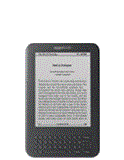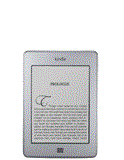Some of the longest running customer demands for the Kindle line have been a touchscreen, a color display, and a price under $100. The Kindle Touch and Kindle Fire each manage a different combination of two out of those three. The big question now is what this means for Kindle owners. Is the addition of these features worth the cost of purchasing a new eReader, even as cheap as they’ve become? For that matter, should people just now coming to the eReader experience jump on the newer Kindle Touch or the Kindle Keyboard being sold for the same price?
In order to facilitate a more informed decision, let’s take a look at what differentiates the two devices:
| Kindle Keyboard |
Kindle Touch | |
 |
 |
|
| Display | 6″ E INK Pearl | 6″ E INK Pearl |
| Connectivity | WiFi + Optional 3G | WiFi + Optional 3G |
| Battery Life | 2 Month | 2 Months |
| Weight | 8.5 – 8.7 Ounces | 7.5 – 7.8 Ounces |
| Dimensions | 7.5″ x 4.8″ x 0.34″ | 6.8″ x 4.7″ x 0.40″ |
| Storage | 4GB (3,500 Books) | 4GB (3,000 Books) |
| Features | Full Physical QWERTY Keyboard | IR Touchscreen, X-Ray, EasyReach |
| Price | $99 – $139 | $99 – $149 |
Not quite as much as one might think, really.
Kindle Touch
The Kindle Touch is the newer device. As might be expected in the portable electronics field, it is smaller, lighter, and faster (if videos posted to highlight the device’s anticipated user experience can be trusted). Removing the physical keyboard seems to have saved about an ounce, which while equaling a weight reduction of over 10% still means little enough to not factor into any decisions. At that point any case you get will probably render the point meaningless anyway. It is also slightly smaller than the Kindle Keyboard, for obvious reasons. You save almost an inch on the vertical and all other measurements are comparable. For a direct comparison, check out the device overlay here:
The real differences that come in stem from software improvements. As you might notice in the table above, though the two Kindles share the same storage space measurement they have different listed book capacities. This is because there are a couple things going on in the Kindle Touch software that the Kindle Keyboard does not have access to, which decreases the available area of the device’s storage a bit.
The less significant, though still quite useful given the interface, is the EasyReach system. This partitions off the touchscreen so that the majority of the screen can be tapped for paging forward while the leftmost edge of the screen will work as a backward page turning button. This eliminates the need for finger swiping. Swiping was certainly a fine idea and emulates the page turning experience found in a paper book to a certain extent, but it gets old after a few hundred pages as anybody who wore out their original Nook can likely attest to.
More importantly, the Kindle Touch will be coming with something called X-Ray. The X-Ray feature is basically intended to be an intelligent extension of the search function, based on Amazon’s description. Not only will it find instances of word use, though, it will supposedly find all instances of a character, idea, place, or topic throughout as well as linking to relevant articles on either Wikipedia or Amazon’s own Shelfari service. How successful this feature is remains to be seen, but Amazon clearly places a lot of confidence in it and emphasizes their own expertise in machine learning and data processing in explaining how they can make such a bold claim. The product page literally says that “The vision is to have every important phrase in every book.” An intriguing, if highly ambitious claim.
Kindle Keyboard
The benefits of a Kindle Keyboard are a bit more modest. Aside from it being a proven device with very few shortcomings attached to it at this point, you also get physical buttons, more application/game options, and a slightly different experience in 3G usage.
The keyboard isn’t the most wonderful thing in the world, but it does the job. This will be a benefit for anybody who prefers feedback on their button pressing. It also means that more of the games and other applications currently available will work for you. For the most part developers have been able to assume the presence of these controls up until this point and it is unlikely that many will be able to adapt to a touchscreen display. This is not to say that there won’t be plenty of games and such that exclusively use the touchscreen in the future, but for now Kindle Keyboard owners have a clear advantage when it comes to non-reading eReader usage.
The 3G coverage that I mentioned is also noticeably more useful than that on the Kindle Touch. Unlike the newer device, the Kindle Keyboard remains able to access the entirety of the internet through this connection (albeit in a sub-par browser), while the new Kindle will be restricted to the Kindle Store and Wikipedia. Anything more is going to require access to a WiFi network, in which situations you will generally be able to access a more internet friendly device anyway. Of course, I am personally taking this as a sign that the Kindle Keyboard is either going to be phased out in the near future or blocked off in a fashion similar to the Kindle Touch, but it is safe to say that current owners and near-future adopters will not be affected.
Conclusions:
When it comes right down to it, there isn’t enough difference between these two to really justify an upgrade. If you own a Kindle Keyboard already and have no particular attachments to touchscreens or potentially super-smart text searches, you shouldn’t feel too bad about waiting a while before getting another eReader. If you’re new to the whole eReader scene, I would probably recommend the $99 Kindle Touch. It is the newest and most likely to be supported in the long term, especially in terms of firmware updates. In addition, you get the touchscreen interface which is certain to be a bit more versatile for most users when compared to the directional control on other Kindles. Completely worth it considering both devices are the same price anyway.
I’ll buy one when it haves the Pocket PC hadwritting feature, so it let me write and correct my articles or tales. Until then, i’ll stick with my 10 years old pocket pc.
Could the keyboard get a firmware update that has x-ray at some point?